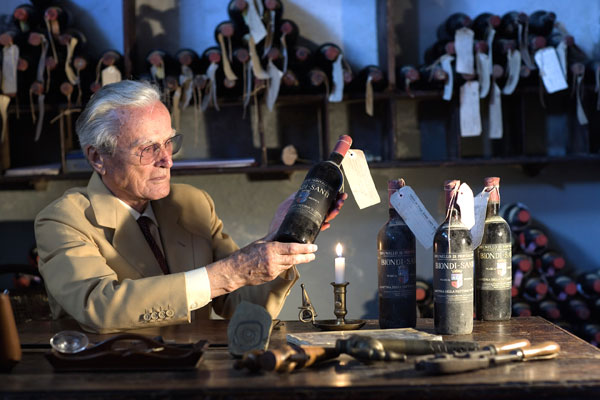Italian winery moves East
 |
|
Franco Biondi-Santi (1922-2013), grandson of the first Biondi-Santi vineyard owner Ferruccio Biondi-Santi, maintained the family traditions. Photos Provided to China Daily |
One of Europe's oldest winemaking families is looking to expand into China with wines that have already won them international acclaim. Han Bingbin reports.
 |
|
Brunello di Montalcino Riserva |
With a history of more than 200 years, one of Italy's most prestigious wineries run by the Biondi-Santi family, is ready to embrace a larger presence in China.
In cooperation with ASC, one of China's leading wine import companies, Biondi-Santi brings to Chinese wine fans a fine selection of three wines, the Brunello di Montalcino, the Brunello di Montalcino Riserva, and the younger Rosso di Montalcino.
The Brunello di Montalcino, the family's first and most influential wine, is already a classic internationally and is well-known among Chinese wine lovers.
It was in the late 19th century that Ferruccio Biondi-Santi, the first owner of the vineyard, planted in "Il Greppo" - a new type of grape called Sangiovese Grosso, which he later renamed Brunello.
The Brunello di Montalcino Riserva series is also a standout collection that can be cellared for 100 years.
The Brunello di Montalcino Riserva 1955 was said to be a favorite of the Queen of England in 1969. It was also once dubbed one of the 20th century's 10 best wines by Wine Spectator magazine in the United States.
The Brunello di Montalcino is made with grapes from vines more than 10 years old. Some of the reserves select grapes from trees older than 25 years.
The Rosso di Montalcino is made from grapes from vines less than a decade old, making it a more approachable wine according to the chateau's current owner, Jacopo Biondi-Santi, who recently visited Beijing.

But Biondi-Santi refuses to call the Rosso an "off-grade label", as it somehow indicates poorer quality. He says the wine has its own style .
"Rosso as an entry level of the Brunello series will guide drinkers to get used to the taste of Brunello. Drinkers starting with Rosso will eventually become followers of the Brunello di Montalcino," he says.
When asked if he feels challenged by the fact that the Chinese market is still dominated by French wines, Biondi-Santi says it's actually an advantage because French wines have successfully trained Chinese consumers to become used to high-end wines.
He says his target consumers in China are wine lovers and collectors who already have an educated palate. And he is glad that the number of people in China drinking and becoming knowledgeable about wine is growing year by year.
According to Biondi-Santi, several hundred years ago Biondi and Santi were actually two families embroiled in a family feud. In 1425, a young Biondi girl married into the Santi family and relations began to thaw.
But the two families really joined in 1850, when a Santi girl married the Biondi family bringing her family assets as a dowry, including the vineyards.
Now, having made wines for 40 years with the 200-year-old technology adopted by his grandfather and refined by his father, Biondi-Santi says he has no plans to change any of his family's winemaking traditions. But he does have a desire for change and innovation.
He now also runs a separate chateau, located 100 kilometers southwest to Montalcino very close to the ocean. Here he has been doing considerable research with Super Tuscany and other grape varieties, actively experimenting with new winemaking technologies. While a respected old tradition is being carefully carried on, a new direction is pointing toward the future.
















